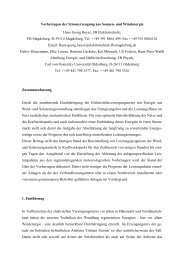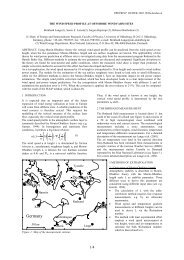forecast of ensemble power production by grid-connected
forecast of ensemble power production by grid-connected
forecast of ensemble power production by grid-connected
You also want an ePaper? Increase the reach of your titles
YUMPU automatically turns print PDFs into web optimized ePapers that Google loves.
intervals are displayed that will be further discussed in<br />
the next section.<br />
The figures shows that there is a good agreement<br />
between <strong>forecast</strong> and measurement for clear sky days<br />
with only minor underestimation <strong>of</strong> the actual <strong>power</strong><br />
output. For cloudy days significant deviations between<br />
<strong>forecast</strong> and measurement may occur. For overcast<br />
situations a considerable overestimation <strong>of</strong> the <strong>power</strong><br />
output can be observed (see Fig.3, 17 th April).<br />
Furthermore, the strong variation <strong>of</strong> the <strong>power</strong><br />
<strong>production</strong> for days with variable clouds is not correctly<br />
modelled <strong>by</strong> the <strong>forecast</strong>.<br />
Figure 3: Predicted <strong>power</strong> output compared to<br />
measured <strong>power</strong> output for seven days in Aril 2006 for a<br />
PV system in Southern Germany.<br />
A quantitative evaluation <strong>of</strong> the <strong>power</strong> <strong>forecast</strong> for the<br />
small <strong>ensemble</strong> <strong>of</strong> 11 PV systems resulted in a rRSME <strong>of</strong><br />
49% (absolute RMSE=0.12Wh/Wp) for April where<br />
cloudy situations were predominant. For July with<br />
mostly clear sky days for this region a lower rRMSE <strong>of</strong><br />
30% (absolute RMSE=0.10 Wh/Wp) is found.<br />
This analysis was complemented with the evaluation <strong>of</strong><br />
predictions <strong>of</strong> irradiance on the tilted plane at the PV<br />
system sites, and an analysis <strong>of</strong> global horizontal<br />
irradiance <strong>forecast</strong>s for meteorological stations located in<br />
the same region. The errors <strong>of</strong> the PV <strong>power</strong> <strong>forecast</strong> are<br />
very closely related to the errors <strong>of</strong> the tilted irradiance<br />
<strong>forecast</strong>, and the RMSE values are similar. This holds<br />
only if the PV system parameters used for the simulation<br />
have a good quality, which was the case for the evaluated<br />
systems.<br />
The quality <strong>of</strong> the global horizontal irradiance <strong>forecast</strong><br />
with a rRMSE <strong>of</strong> 44% for April and a rRMSE <strong>of</strong> 28% for<br />
July is slightly better than the quality <strong>of</strong> the tilted<br />
irradiance and PV <strong>power</strong> <strong>forecast</strong>. Forecast errors are<br />
amplified <strong>by</strong> conversion <strong>of</strong> the irradiance on the tilted<br />
plane. But, given correct parameters to characterize the<br />
PV systems, the accuracy <strong>of</strong> the global horizontal<br />
irradiance <strong>forecast</strong> is still the determining factor for the<br />
quality <strong>of</strong> the <strong>power</strong> <strong>forecast</strong>.<br />
6 CONFIDENCE INTERVALS<br />
The specification <strong>of</strong> the <strong>forecast</strong> accuracy is an important<br />
issue for an effective application <strong>of</strong> the <strong>forecast</strong>s.<br />
Therefore, confidence intervals are provided that indicate<br />
the range in which the actual value is expected to appear<br />
with a quantified probability (see illustration in Fig. 4).<br />
To derive the limits <strong>of</strong> the confidence intervals, a model<br />
for the distribution <strong>of</strong> the scatter <strong>of</strong> the actual value<br />
around the <strong>forecast</strong> is needed. As the range <strong>of</strong> possible<br />
values is limited <strong>by</strong> zero and the <strong>power</strong> output at clear<br />
sky conditions, a natural choice for a respective<br />
distribution model is the beta distribution, already<br />
applied in the context <strong>of</strong> wind <strong>power</strong> <strong>forecast</strong>s [6]. This<br />
model is applied to the small <strong>ensemble</strong> <strong>of</strong> 11 Southern<br />
German PV systems.<br />
Figure 4: Predicted <strong>power</strong> output with confidence<br />
intervals compared to measured <strong>power</strong> output for seven<br />
days in July 2006 for a PV system in Southern Germany.<br />
Basis for the determination <strong>of</strong> the confidence intervals is<br />
the knowledge <strong>of</strong> the situation-specific RMSE <strong>of</strong> the<br />
<strong>forecast</strong>. Together with the <strong>forecast</strong>ed value itself it may<br />
define the beta distribution for the expected actual<br />
values.<br />
These specific RMSE values are determined with<br />
dependence on sun elevation and cloud situation<br />
(homogeneous or scatter) using BIAS-corrected <strong>forecast</strong><br />
values.<br />
For this analysis only a limited number <strong>of</strong> measurements<br />
was available. Therefore, only three different classes <strong>of</strong><br />
cloud situations are distinguished: clear sky, overcast,<br />
and broken clouds. The characterization <strong>of</strong> the classes<br />
was based on the mean clear sky index and the standard<br />
deviation <strong>of</strong> the clear sky index <strong>of</strong> the <strong>forecast</strong> field <strong>of</strong> all<br />
11 PV systems. The clear sky index k* is a measure <strong>of</strong><br />
cloudiness, defined as the ratio <strong>of</strong> global irradiance to<br />
clear sky irradiance.<br />
Given the beta distribution, the limits <strong>of</strong> the confidence<br />
interval can be directly calculated. Here, we choose a<br />
confidence level <strong>of</strong> 90%. Fig. 5 shows an example for the<br />
derived confidence intervals for April and sun elevations<br />
between 40 o and 50 o for the three different classes <strong>of</strong><br />
cloud situations. The figure illustrates that the confidence<br />
intervals provide a reasonable estimate for the expected<br />
maximum deviation <strong>of</strong> the measured from the predicted<br />
values. However, a considerable number <strong>of</strong> values also is<br />
found outside the confidence intervals. A quantitative<br />
evaluation revealed, that only about 80%- 85% <strong>of</strong> the<br />
measured values are found within the confidence<br />
intervals for each class instead <strong>of</strong> the expected 90%.<br />
Reasons for this insufficiency may be found in the fact,<br />
that the choice <strong>of</strong> only two parameters (mean value and<br />
spatial standard deviation the clear sky index k*) to<br />
derive the RMSE data is insufficient, especially taking<br />
into account that the systems analyzed show different








